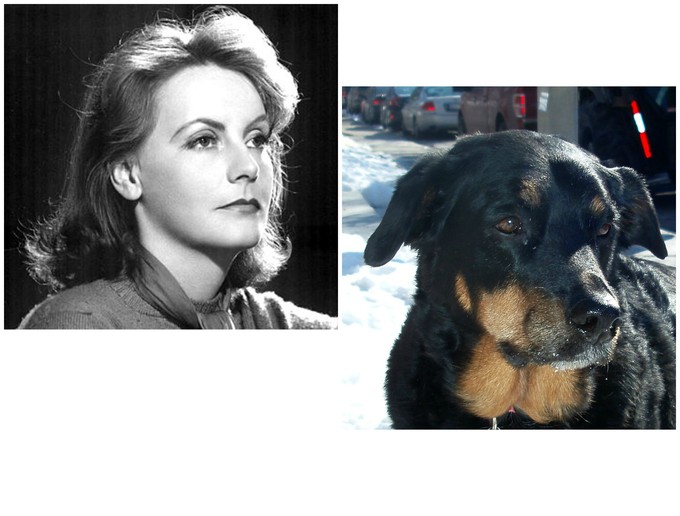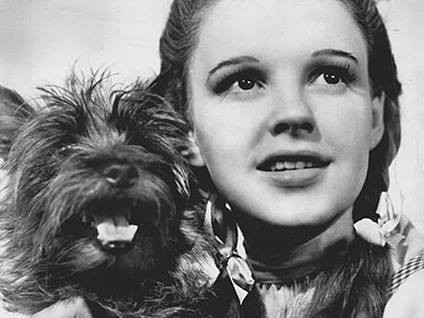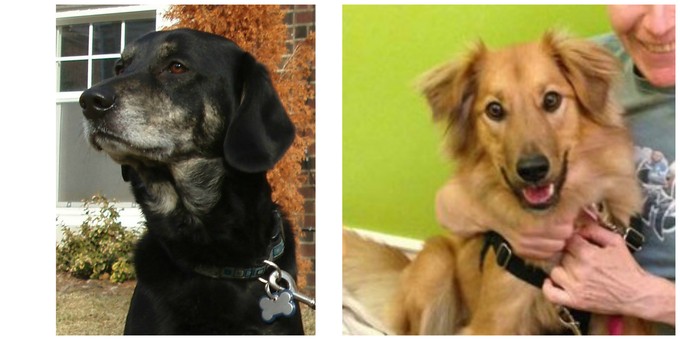I vant to be alone:
separation anxiety and its flip side(s)

Greta Garbo and Sasha: whether in a Grand Hotel or a family home, stressed out beings need time alone.
In the 1932 movie Grand Hotel, Greta Garbo wants to be alone, and these days, so does Sasha. "Stay out of my face," is her attitude towards other dogs, unusual for Sash. She and her human have moved in, temporarily, with extended family. Their new digs include three kids, ages 4-8, and Captain Cheeseburger, a ten month old male Bouvier. Captain C is the epitome of his playful breed, and is bigger and more batshit than the nine-year-old Sash. Of course Sasha vants to be alone.
Most of us know about dogs and separation anxiety, and we appreciate its flip side: sometimes a dog needs a room of her own. But what about separation anxiety's other flip side: humans who fret when away from their dogs? We are less obvious than our canine counterparts. We don't bark vociferously or shit where we shouldn't. Still, I've seen subtle signs of separation anxiety in people, including myself.
It took me a while to recognize it, possibly because I am the kind of person who tells her friends, "If the phone doesn't ring, it's me," (a line borrowed from Jimmy Buffet). With humans, I am a lone wolf. But when it comes to my dogs, I've noticed that over the years I've developed a homing instinct: get back to the pack.
With my first dog, Mim, separation anxiety wasn't an issue. True, Mim came to work with me at the Women's Centre every day, and went along on all my errands, so we were rarely apart. But I had no trepidation about leaving her. Mim was a confident dog; there was a great adventure waiting for her around every corner, with or without me.
There were a couple of red flag incidents that hinted at future problems — for me, not the dog. Once, when Mim had a typical puppy virus and was too barfy to come to the office, I cried on the walk to work without her. Uh oh. I'm not, as a rule, a crier.
Mim and I were also separated when I participated in an occupation at the university. Mim attended the support rallies outside. She could hear my voice, and I could hear her bark. I had a hard time maintaining my 'Stay,' but political commitment and the conviction that Mim was fine without me kept me from leaping out the window to join her.

Ever notice that Dorothy is more worried about her separation from Toto than vice versa?
It wasn't until Hillary, aka The Cling-On, arrived that I became consciously uneasy about leaving the dogs. Hillary liked constant physical contact. She forged a joined-at-the-hip bond with me, and she was equally super-glued to Mim. Though she was not distressed by my departures, she was like a frenzied Elvis fan on my returns.
After Hill joined the pack, I noticed that when I left the apartment, I often felt a flash of fear. I ruminated: Did I leave enough water for them? Did Hillbilly's sneezing mean she had kennel cough? Would the apartment burn down in my absence? Hillary's anxiety had apparently allowed my own to surface. It usually dissipated quickly, but a little tension lingered, relieved only by my return home.
I've seen similar feelings in clients. Often they don't know that they're anxious. I know, because I get multiple calls or emails before each walk. They want to change the pick up time, again; they mention a minor health matter (stool quality, itchy ears); they remind me their dog is squirrel-obsessed; and so on. The number of calls, rather than their content, points to their anxiety. Separation anxiety is high maintenance, whether canine or human — sometimes the ratio of calls to walks exceeds 3:1.
When people travel, they sometimes conflate the feeling 'I'll miss my dog' with 'my dog won't be OK without me.' If a client gets really unsettled, I redirect their attention to the former: what will they miss most about their dog? One recently told me she'd miss their nightly ritual of eating an apple together. After our discussion, she stopped fretting that I wouldn't feed him breakfast on time.
The DSM-V, the handy-dandy diagnostic book for shrinks, lists adult separation anxiety as a disorder (I'm pretty sure it doesn't mention dogs as attachment objects — typical anthropocentrism). A few years ago one of my friends asked his doctor to write a note declaring his dog a therapy dog. I wondered whether he was blurring the line between 'medically need' and 'really want.' My friend was adamant: he needed his dog with him all the time to feel OK. He mentioned it was better to depend on his dog than on crystal meth, his previous coping mechanism of choice. Fair enough.

In my current home-pack, McCracken likes a room of his own, but Notley is more of a velcro dog.
Naturally, the tech industry has noticed our desire to stay connected to our pets, and there are now at least two brands of camera/ interactive video/ treat dispensers available. While we're at work, we can interrupt our napping dog, say hello via video, and offer her a treat. Watching the ads for these gizmos, I can't imagine using one. Then again, as a dog walker, I spend much of the day with my dogs, so I'm not their target market.
Most dog people know that for a span of time the dogs are OK without us, and we're OK without them — but that 'with' is better.
New connect-a-pet technologies:
https://www.petzi.com/
https://petchatz.com/
Want to make a comment and avoid registering with Disqus? Click on 'join the discussion' and in the name field at the bottom of the form check "I'd rather post as a guest." A name and email address are still required.